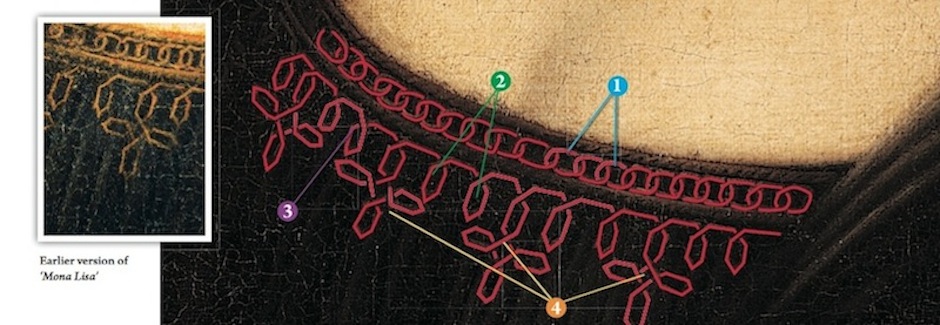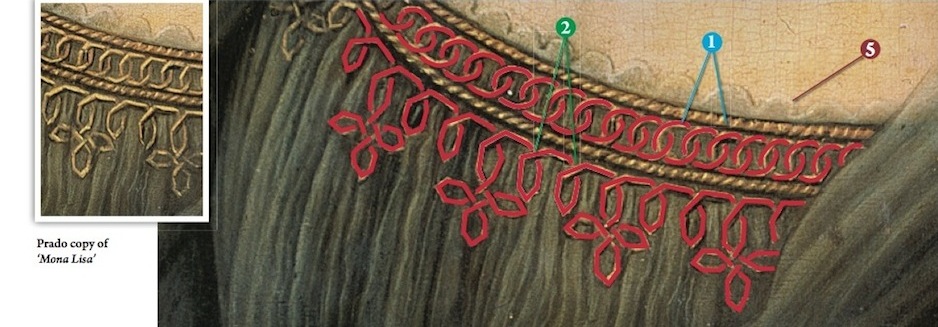Leonardo’s passion, almost obsession, for knots has been touched on in previous chapters, but this topic is like the very subject itself: it is a thread that runs continuously through his life. Therefore no comparative study of Mona Lisa would be complete without further analysis of this element. It has been pointed-out how some of Leonardo’s fascination with knots stems from his own name and the area around Vinci where he grew up. In addition, there is a sense that he was already toying in the 15th Century with what since became known in the 20th Century as Fractal Geometry.
“He also spent a great deal of time in making a pattern of a series of knots, so arranged that the connecting thread can be traced from one end to the other and the complete design fills a round space. There exists a splendid engraving of one of these fine intricate designs with these words in the centre: Leonardus Vinci Academia”. Giorgio Vasari
What makes a work of art superb can often be found in the execution of the small details. In the words of the famous Irish writer James Joyce: “ … In the particular is contained the universal.” The depictions of the embroidery patterns at the top of Mona Lisa’s bodice are more than mere pretty designs. It is argued here that Leonardo is both exercising his skill at rendering intricate brushwork, and also telling us a particular story. In addition, he is likely deliberately confounding any would-be copyist. Furthermore, Leonardo also focused on this element in other paintings where knot patterns form part of the clothing details. Examples of intricate knot patterns exist in the ‘Lady with an Ermine’ and ‘La Belle Ferronniere’.
EMBROIDERY & KNOT-WORK COMPARISONS
1: The upper – “chain-link” – pattern
‘Earlier Mona Lisa’: is rendered in a loose horizontal style.

Louvre ‘Mona Lisa’: depicts a tighter, more vertical oval design; a further confirmation of the two paintings being separate and distinct works.
 Oslo ‘Mona Lisa’: exactly follows the horizontal design of the ‘Earlier Mona Lisa’.
Oslo ‘Mona Lisa’: exactly follows the horizontal design of the ‘Earlier Mona Lisa’.
 Prado ‘Mona Lisa’: is unlike the others, neither strictly horizontal nor vertical, but more round in shape.
Prado ‘Mona Lisa’: is unlike the others, neither strictly horizontal nor vertical, but more round in shape.

2: The loops between the “cloverleafs”
‘Earlier Mona Lisa’: shows a continuity of two loops between each cloverleaf knot on the bodice.
Louvre ‘Mona Lisa’: Leonardo went ‘out of sequence’ in the central section by using three loops between the cloverleafs there. From this, it can be surmised that this painting was not only different from the ‘Earlier Mona Lisa’, but that it – at least the bodice – was likely painted at a later date. The display of three loops in the centre is another indication of an intention to separate the paintings. The Louvre ‘Mona Lisa’ is the only painting of this subject known to use this secret three-loop detail. This is also another possible Leonardesque clue. Because of the similarity of the bodices in particular, and the clothing in general he is deliberately identifying the sitter. How likely would it have been that two different women would be wearing a similar dress?
Oslo ‘Mona Lisa’ and Prado ‘Mona Lisa’: Both display a repetitive pattern of two loops between each cloverleaf.
3: Irregularities in the ‘loop’ designs
With regard to the loop designs between the cloverleafs, the artist occasionally threaded one or two in the opposite sequence: a whim? Or deliberately to confuse copyists?
4: Irregularities in the ‘cloverleaf ’ knotting
‘Earlier Mona Lisa’: every single cloverleaf cluster has a unique pattern, identified by a singular difference in the threading of the knot design displaying the four unique threading possibilities, leaving no two the same. This matter alone significantly identifies the ‘Earlier Mona Lisa’ as a unique original work. To do this required a skillful determination in advance to display all four possibilities with each of the four cloverleafs making each one unique. Neither the Louvre painting nor any of the copies reflect this complex and mathematically perfect work.
Louvre ‘Mona Lisa’: has a cloverleaf pattern where the threading is repeated in exactly the same way in each cluster.
Oslo ‘Mona Lisa’ and Prado ‘Mona Lisa’: the cloverleafs in both display a consistent repetitive pattern.
5: The frill
Prado ‘Mona Lisa’: a delicate frill at the top of the bodice is clearly visible. In the others, however, this frill detail is no longer visible, though it is possible to see a few traces under intense magnification. It does stand to reason that a dress of such quality would have been trimmed with this material. Because of the close association of the Prado ‘Mona Lisa’ with the Louvre ‘Mona Lisa’, it is considered that the earlier and Louvre Mona Lisas, as well as the numerous copies, would originally have had this detail.
Almost without exception, every copy and version of Mona Lisa displays embroidery patterns of just two loops between the cloverleafs, and not one has replicated either the unique variation of that third loop, or the unique thread patterns found in the ‘Earlier Mona Lisa’. Furthermore, artists who have meticulously tried to copy either one set of patterns or the other, have perhaps inadvertently continued to prove that the two originals were different from each other, and never intended to be copies of each other. So, it is argued here that in his two portraits of Mona Lisa, Leonardo gets to indulge his whimsy of knot patterns; he may also be informing us that he had always intended that the two paintings would be slightly different; and his intricacies, perhaps at the time known only to himself, confound copyists and it seems even many art historians, to this day. [See Lorusso and Natali for a further discussion of this point]